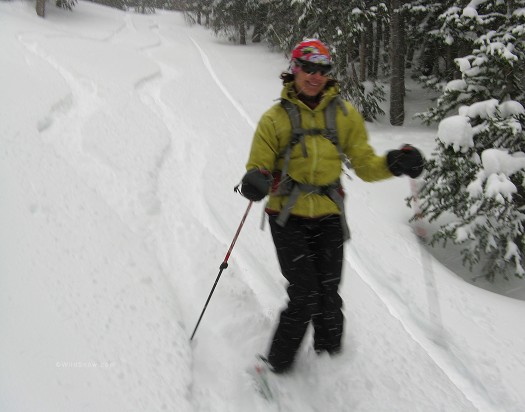When the avalanche predictions are Katrina II, what to do? How about skiing your zone where familiarity breeds complacency but also helps you find the safe routes. So our weekend shook out like this: Friday, head up to Marble, Colorado with assistant Joe and make a run on a skied-out safe zone. Saturday do a couple of uphill fitness laps at Aspen resort so Lisa could test out her newly fitted TLT5 ski boots. Sunday, back in Marble at WildSnow Field HQ with my bride for some meadow skipping and picnic lunch. Not exactly the makings of a new TGR film, but then, our millieu here at WildSnow is not exactly helicopter supported spine skiing. Instead, we simply love getting out, under our own power, doing anything ski related in the mountains.
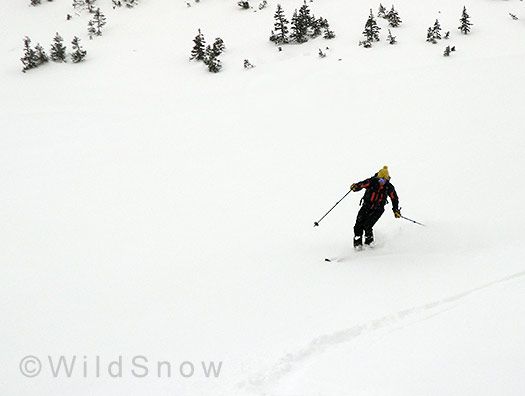
Joe this weekend in Colorado, in the safe zone. We've got him set up with Scarpa Rush boots, for the time being using G3 Zen Oxide from the Ultimate Quiver. His Dynafit Radical 12 binders have the heel pin removed and they seem to avoid auto-rotation when set to fairly high release value as Joe chooses to do. He's adjusting to a softer backcountry setup after many days on the resorts this winter in his alpine gear.
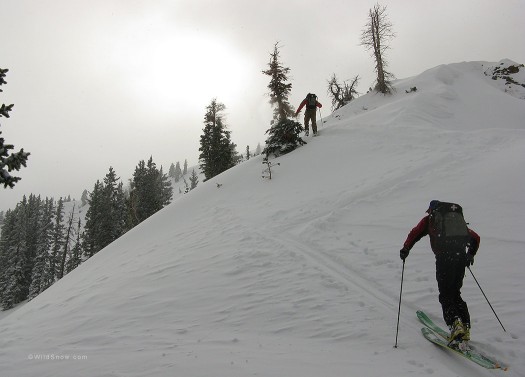
These guys set well designed skin track, and were playing a good game of 'safe zone' themselves, though a bit less conservative than my sometimes overly excessive nod to caution.
So, what’s going on with our snowpack? If you live up in the PNW or Canadian coastal, perhaps you’ll smile smugly as you learn our plight here in continental Rockies. Sympathy, please. Yes, we’ve got facet piles deep enough to cover the Great Pyramid, and “sucker snow” bridging that I’m fervently praying does not create tragedy as our snowpack “feels” okay but hides deadly consequences. For those of you new to the game (or old hands wanting a refresher course), check out the Tremper video below. He certainly sets things out in learnable fashion.
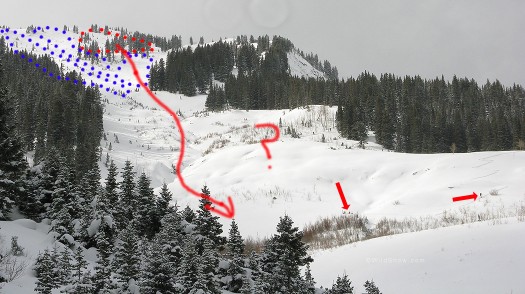
Marble Peak avalanche path this past Sunday. Lisa and I caught this view while doing some adjacent meadow skipping. Due to ski compaction the thing rarely runs full path anymore. Before it became popular as a backcountry run it ran full several times during some winters, and truly huge every few years (to the point of removing mature spruce trees). The upper bowl stays quite ski compacted, but nonetheless new storm snow can make it dangerous. The blue outlines are approximately where skier triggered avalanches fell a short time ago. While those slides put a good scare in nearby skiers, they served to substantially stabilize that area of the bowl. But, and it's a big but, the area outlined by red is still hanging and could run as indicated by rough drawn arrow, or larger. Yeah, it's a bit more south-southeast facing, but I've seen that section pull out during bad facet years such as this. Something to consider, especially if you're the guys messing around and it appears digging a snowpit as indicated by the middle arrow. The right arrow indicates a skier on the common uptrack, in an area with sometimes a bit disconcerting exposure to danger. Interestingly, in my opinion it's actually safer to climb a bit left of where the skin track goes at it's upper reach. Why? Because the more south-easterly snow in that section is much more stable than that of the stuff that starts to tilt northerly. More, the consequences of a smaller slide can be severe if you're on the upper portion of the existing skin track shown in the photo (it strainers through steep trees). By staying a bit farther left, you're in lower consequence terrain. Of course all that is moot if the big one comes down from above, but as I mentioned, that's rare now. Interesting chess game, as some days you'd perhaps be scared of the big one and stay farther right, other days, more left... and so on.
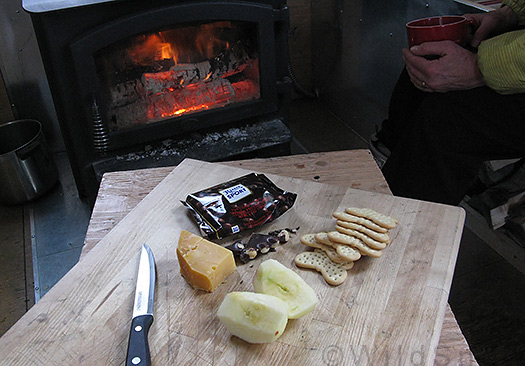
Back at the ranch.
WildSnow.com publisher emeritus and founder Lou (Louis Dawson) has a 50+ years career in climbing, backcountry skiing and ski mountaineering. He was the first person in history to ski down all 54 Colorado 14,000-foot peaks, has authored numerous books about about backcountry skiing, and has skied from the summit of Denali in Alaska, North America’s highest mountain.

